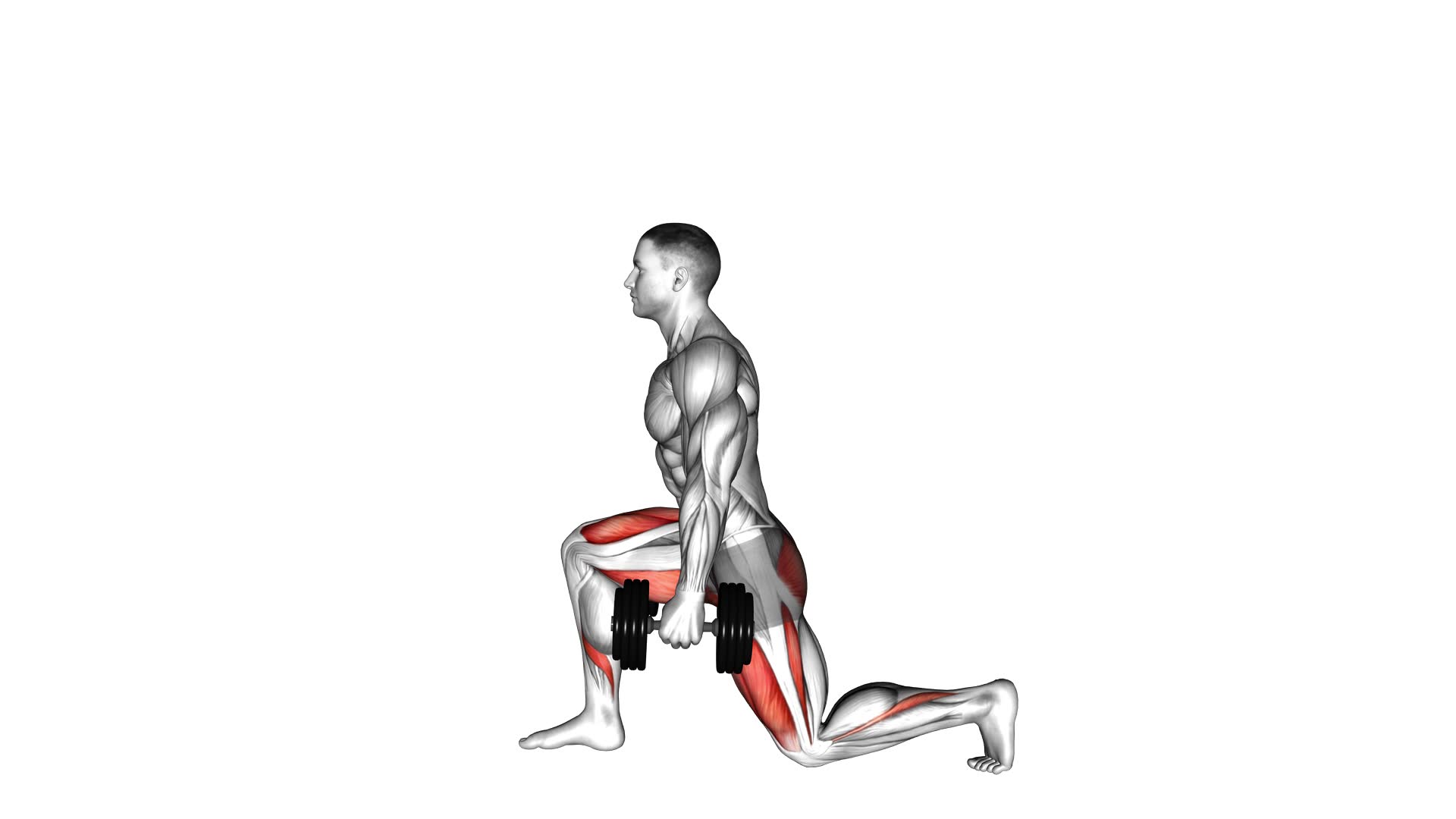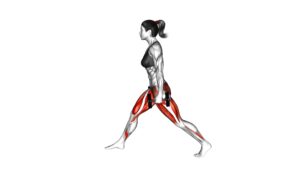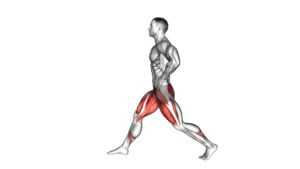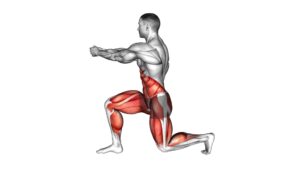Dumbbell Static Lunge – Video Exercise Guide & Tips

Looking to tone your legs and build strength? The dumbbell static lunge is the perfect exercise for you.
Watch This Exercise Video
In this video exercise guide, we'll show you proper form, common mistakes to avoid, and variations to keep you challenged.
With our expert tips, you'll maximize your results and get the most out of this powerful exercise.
So grab your dumbbells and get ready to lunge your way to a fitter you!
Key Takeaways
- Targets multiple muscle groups simultaneously (quadriceps, hamstrings, glutes, and calves)
- Improves muscular endurance and increases calorie burn
- Enhances balance and stability
- Allows for effective lunge variations
Benefits of the Dumbbell Static Lunge
Discover the numerous benefits you can experience by incorporating the dumbbell static lunge into your fitness routine.
The dumbbell lunge technique, when performed correctly, can yield significant results in terms of strength, stability, and overall lower body development. One of the main advantages of the dumbbell static lunge is its ability to target multiple muscle groups simultaneously. By engaging the quadriceps, hamstrings, glutes, and calves, this exercise provides a comprehensive lower body workout. Additionally, the use of dumbbells adds an extra challenge, helping to improve muscular endurance and increase calorie burn.
Moreover, the dumbbell static lunge allows for effective lunge variations, which can further enhance its benefits. For instance, by incorporating a forward or backward lunge, you can shift the emphasis onto different muscles and increase the overall difficulty of the exercise. The dumbbell static lunge also improves balance and stability, as you're required to maintain a stable position throughout the movement. This can have a positive impact on your daily activities and reduce the risk of falls or injuries.
Lastly, the dumbbell static lunge is a time-efficient exercise that can be easily incorporated into any workout routine. With its numerous benefits, it's no wonder that the dumbbell static lunge is a popular choice among fitness enthusiasts.
Proper Form and Technique
To perform the dumbbell static lunge with proper form and technique, you should start by standing upright with a dumbbell in each hand. Keep your feet shoulder-width apart, and your toes pointing forward. Take a step forward with your right foot, ensuring that your knee is directly above your ankle. Lower your body by bending both knees until your left knee is almost touching the ground. Make sure to keep your back straight throughout the movement. Push through your right foot to return to the starting position. Repeat the movement with your left leg.
Maintaining proper form and technique is crucial when performing dumbbell lunges. It helps to engage the correct muscles and prevents injuries. Remember to keep your core tight throughout the exercise to improve stability. Additionally, be mindful of your knee alignment and avoid letting your knees collapse inward.
There are also various lunge variations you can try to add variety and challenge to your workout. Some examples include walking lunges, reverse lunges, and lateral lunges. Each variation targets different muscles and adds a new dimension to your training. However, it's essential to master the basic dumbbell static lunge before progressing to more advanced variations. By practicing proper form and technique, you can maximize the benefits of dumbbell lunges while minimizing the risk of injury.
Common Mistakes to Avoid
To ensure you're performing the dumbbell static lunge correctly and avoiding common mistakes, it's important to pay attention to proper form demonstration and be aware of the correct technique.
This will help you avoid errors such as leaning too far forward, allowing your knee to go past your toes, or not maintaining proper alignment of your upper body.
Proper Form Demonstration
Avoid these three common mistakes when performing the dumbbell static lunge.
Firstly, make sure to maintain proper balance throughout the exercise. Many people tend to lean too far forward or backward, which can strain the muscles and reduce the effectiveness of the lunge. Keep your chest up, shoulders back, and core engaged for optimal balance.
Secondly, target the specific muscle groups by focusing on proper form. It's important to ensure that your knees are aligned with your toes and that you're lowering yourself down to a 90-degree angle.
Lastly, avoid rushing through the exercise. Take your time to perform each repetition with control and precision to maximize the benefits and reduce the risk of injury.
Correcting Common Errors
Maintain proper balance and correct any common mistakes while performing the dumbbell static lunge to maximize its effectiveness.
To ensure proper form and avoid common mistakes, keep the following tips in mind.
First, make sure your front knee is directly above your ankle and not extending beyond your toes. This helps prevent unnecessary strain on the knee joint.
Second, keep your core engaged and maintain an upright posture throughout the exercise. Avoid leaning forward or rounding your back, as this can lead to poor form and potential injury.
Lastly, focus on controlling your movements and avoid rushing through the exercise. By taking your time and performing each lunge with control, you can better target the muscles and improve overall stability.
Variations and Progressions
Are there different ways you can progress the Dumbbell Static Lunge exercise? Absolutely! By incorporating variations and progressions into your workout routine, you can continue to challenge your muscles and improve your strength and stability.
One variation you can try is the lateral lunge. Instead of stepping forward or backward, you'll take a big step to the side, lowering your body into a lunge position. This variation targets your inner and outer thighs, providing a different stimulus to your muscles.
Another progression is the reverse lunge. Instead of stepping forward, you'll step backward into the lunge position. This variation places more emphasis on your glutes and hamstrings, helping to develop better hip stability and balance.
To further increase the difficulty, you can add weight by holding dumbbells in each hand or using a barbell across your shoulders. This added resistance will challenge your muscles even more, promoting further strength gains.
Tips for Maximizing Results
To maximize your results with the Dumbbell Static Lunge exercise, focus on proper form and gradually increase the intensity of your workouts. Here are some tips to help you achieve maximum results:
- Maintain proper posture: Keep your back straight, chest lifted, and shoulders relaxed throughout the exercise. This will engage your core and prevent strain on your lower back.
- Step out with control: When performing the lunge, take a big step forward and lower your body by bending both knees. Make sure to control the movement and avoid any jerking motions.
- Engage your glutes: To maximize the effectiveness of the exercise, focus on squeezing your glutes as you push back up to the starting position. This will target your glute muscles and help to build strength and definition.
By following these proper form tips and gradually increasing the intensity of your workouts, you can maximize the results of the Dumbbell Static Lunge exercise. Remember to always listen to your body and adjust the weights and repetitions as needed.
With consistency and dedication, you'll be on your way to achieving your fitness goals.
Sample Dumbbell Static Lunge Workout Plan
Now that you understand the proper form and technique for the dumbbell static lunge, let's discuss a sample workout plan.
This plan will include tips on maintaining proper form, variations you can incorporate, and the benefits of including lunges in your routine.
Proper Form Tips
How can you perform the dumbbell static lunge with proper form in your workout plan? Here are some tips to help you get it right:
- Keep your upper body straight and engage your core for stability.
- Take a long step forward with one leg while keeping your back straight.
- Lower your body until your front knee is at a 90-degree angle, making sure your knee doesn't go past your toes.
Common mistakes to avoid when doing dumbbell static lunges include:
- Leaning forward or rounding your back, which puts unnecessary strain on your lower back.
- Allowing your knee to go past your toes, which can lead to knee pain or injury.
- Neglecting to engage your core, which can result in a lack of balance and stability.
Variation Options
For a more challenging workout, incorporate different variations into your dumbbell static lunge routine.
There are several dumbbell static lunge modifications and alternative lunge variations that you can try to target different muscle groups and intensify your workout.
One option is to add a twist to the exercise by holding the dumbbell at your chest and rotating your torso as you lunge forward. This engages your obliques and adds an extra challenge to your core.
Another modification is the reverse dumbbell static lunge, where you step backward instead of forward. This variation puts more emphasis on your glutes and hamstrings.
You can also try a walking dumbbell static lunge, where you take steps forward or backward while performing the lunge. This increases the difficulty and adds a cardio element to your routine.
Don't be afraid to mix and match these variations to create a sample dumbbell static lunge workout plan that suits your fitness goals.
Benefits of Lunges
To maximize the benefits of lunges and create an effective sample dumbbell static lunge workout plan, incorporate different variations into your routine. Lunges aren't only great for toning and strengthening your leg muscles, but they also offer a range of other benefits. Here are three reasons why you should add lunges to your fitness regimen:
- Lunges for weight loss: Incorporating lunges into your workout routine can help you burn calories and lose weight. They engage multiple muscle groups, including your glutes, quads, and hamstrings, resulting in a higher calorie burn compared to other exercises.
- Lunges for glute activation: If you want to target and activate your glute muscles, lunges are a fantastic exercise choice. By performing lunges, you can strengthen and tone your glutes, giving you a firmer and more lifted appearance.
- Variation options: Lunges offer a variety of variations that can help you target different muscle groups and add variety to your workouts. Some popular lunge variations include walking lunges, reverse lunges, and lateral lunges.
Incorporating lunges into your routine can help you achieve your fitness goals, whether it's weight loss or building stronger glutes. So, don't forget to include lunges in your next workout!
Frequently Asked Questions
How Many Sets and Reps Should I Do for the Dumbbell Static Lunge?
To determine the number of sets and reps for the dumbbell static lunge, you should consider your fitness level and goals. Generally, it's recommended to perform 2-4 sets of 8-12 reps per leg.
However, you can adjust the sets and reps based on your preferences and abilities. Additionally, there are variations of the dumbbell static lunge that you can incorporate into your workout routine to add variety and challenge.
Can I Do the Dumbbell Static Lunge Without Weights?
Yes, you can do the dumbbell static lunge without weights. This exercise is a great lower body workout that targets your quadriceps, glutes, and hamstrings.
Adding dumbbells can increase the intensity and provide extra resistance for greater muscle activation. If you don't have access to dumbbells, you can try alternatives like using a resistance band or even just your body weight.
Is the Dumbbell Static Lunge More Effective for Building Leg Muscle Compared to Other Lunge Variations?
The dumbbell static lunge is a great exercise for building leg muscle compared to other lunge variations. It offers unique benefits and advantages.
By incorporating dumbbells into the exercise, you increase the resistance and intensity, leading to greater muscle activation in the legs. This helps to develop strength, stability, and overall muscle tone in the lower body.
Can I Incorporate the Dumbbell Static Lunge Into a Full-Body Workout Routine?
Yes, you can definitely incorporate the dumbbell static lunge into your full-body workout routine. It offers numerous benefits for overall strength and conditioning.
By adding the dumbbell static lunge to your workout, you engage multiple muscle groups simultaneously, including your legs, glutes, and core. This exercise also helps improve balance and stability.
Incorporating the dumbbell static lunge will provide a challenging and effective workout for your entire body.
Can the Dumbbell Static Lunge Help Improve My Balance and Stability?
Improving your balance and stability is an important aspect of any workout routine. The dumbbell static lunge can be a great exercise to help you with that.
By holding dumbbells in each hand and lunging forward, you're challenging your lower body muscles while also engaging your core for stability.
This exercise requires concentration and control, which can greatly enhance your balance and stability over time.
Conclusion
In conclusion, the dumbbell static lunge is a highly effective exercise for strengthening and toning the lower body muscles.
By maintaining proper form and avoiding common mistakes, you can maximize your results and prevent injuries.
Adding variations and progressing in difficulty will challenge your muscles even more.
Incorporating this exercise into your workout routine can help you achieve your fitness goals and improve your overall strength and stability.

Author
Years ago, the spark of my life’s passion ignited in my mind the moment I stepped into the local gym for the first time. The inaugural bead of perspiration, the initial endeavor, the very first surge of endorphins, and a sense of pride that washed over me post-workout marked the beginning of my deep-seated interest in strength sports, fitness, and sports nutrition. This very curiosity blossomed rapidly into a profound fascination, propelling me to earn a Master’s degree in Physical Education from the Academy of Physical Education in Krakow, followed by a Sports Manager diploma from the Jagiellonian University. My journey of growth led me to gain more specialized qualifications, such as being a certified personal trainer with a focus on sports dietetics, a lifeguard, and an instructor for wellness and corrective gymnastics. Theoretical knowledge paired seamlessly with practical experience, reinforcing my belief that the transformation of individuals under my guidance was also a reflection of my personal growth. This belief holds true even today. Each day, I strive to push the boundaries and explore new realms. These realms gently elevate me to greater heights. The unique combination of passion for my field and the continuous quest for growth fuels my drive to break new ground.







